Approaches for Sustainable Development in Business Environment
VerifiedAdded on 2023/06/04
|19
|3694
|382
AI Summary
This report discusses the five approaches for sustainable development in business environment, including the triple bottom line, five capitals, natural capitalism, cradle to cradle, and the circular economy. It also evaluates the implementation of cradle-to-cradle and balance scorecard approaches in Kellogg's cereal company.
Contribute Materials
Your contribution can guide someone’s learning journey. Share your
documents today.
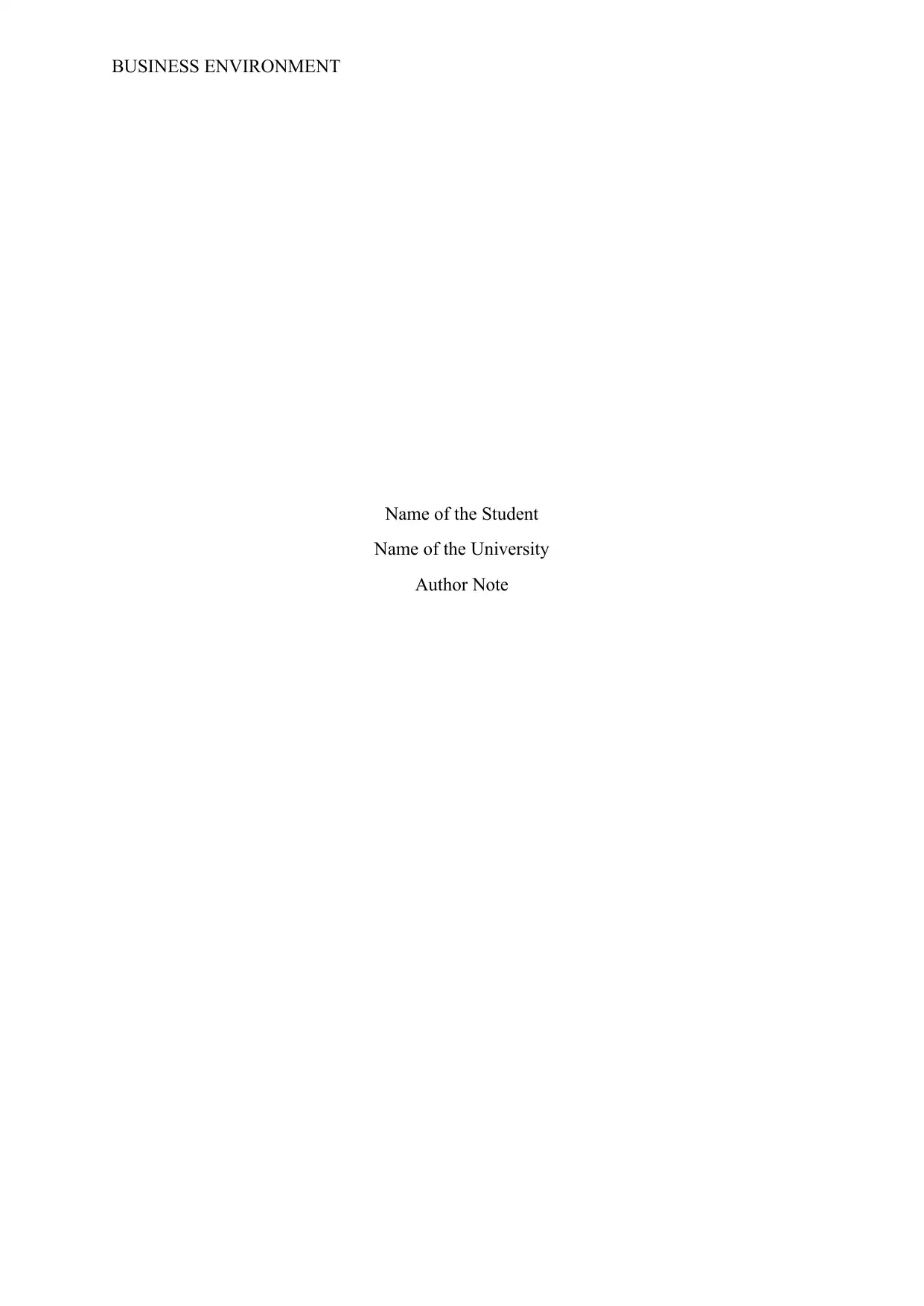
BUSINESS ENVIRONMENT
Name of the Student
Name of the University
Author Note
Name of the Student
Name of the University
Author Note
Secure Best Marks with AI Grader
Need help grading? Try our AI Grader for instant feedback on your assignments.
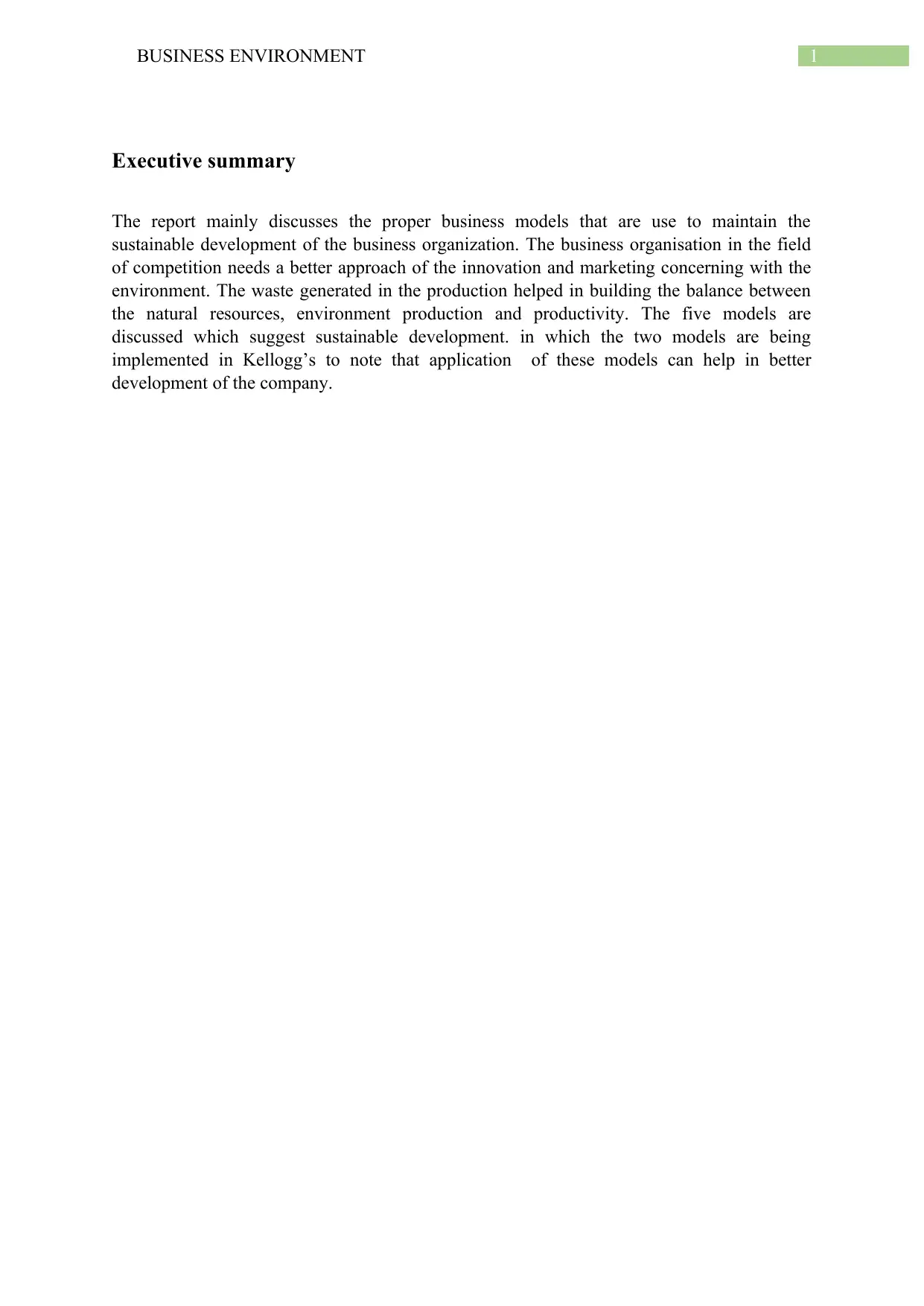
1BUSINESS ENVIRONMENT
Executive summary
The report mainly discusses the proper business models that are use to maintain the
sustainable development of the business organization. The business organisation in the field
of competition needs a better approach of the innovation and marketing concerning with the
environment. The waste generated in the production helped in building the balance between
the natural resources, environment production and productivity. The five models are
discussed which suggest sustainable development. in which the two models are being
implemented in Kellogg’s to note that application of these models can help in better
development of the company.
Executive summary
The report mainly discusses the proper business models that are use to maintain the
sustainable development of the business organization. The business organisation in the field
of competition needs a better approach of the innovation and marketing concerning with the
environment. The waste generated in the production helped in building the balance between
the natural resources, environment production and productivity. The five models are
discussed which suggest sustainable development. in which the two models are being
implemented in Kellogg’s to note that application of these models can help in better
development of the company.

2BUSINESS ENVIRONMENT
Table of Contents
Executive summary....................................................................................................................1
Introduction................................................................................................................................3
Approaches.................................................................................................................................4
The triple bottom line:............................................................................................................4
Five capitals:..........................................................................................................................5
Natural capitalism:.................................................................................................................6
Cradle to cradle......................................................................................................................6
The circular economy.............................................................................................................7
The balance scorecard............................................................................................................7
Discussion..................................................................................................................................7
Using the cradle-to-cradleapproach inKellogg’s cereal company.........................................8
Using the approach “the balance score card”...........................................................................10
Comparison..............................................................................................................................11
Conclusion................................................................................................................................12
References................................................................................................................................13
Appendix 1...............................................................................................................................15
Appendix 2...............................................................................................................................16
Table of Contents
Executive summary....................................................................................................................1
Introduction................................................................................................................................3
Approaches.................................................................................................................................4
The triple bottom line:............................................................................................................4
Five capitals:..........................................................................................................................5
Natural capitalism:.................................................................................................................6
Cradle to cradle......................................................................................................................6
The circular economy.............................................................................................................7
The balance scorecard............................................................................................................7
Discussion..................................................................................................................................7
Using the cradle-to-cradleapproach inKellogg’s cereal company.........................................8
Using the approach “the balance score card”...........................................................................10
Comparison..............................................................................................................................11
Conclusion................................................................................................................................12
References................................................................................................................................13
Appendix 1...............................................................................................................................15
Appendix 2...............................................................................................................................16

3BUSINESS ENVIRONMENT
Secure Best Marks with AI Grader
Need help grading? Try our AI Grader for instant feedback on your assignments.

4BUSINESS ENVIRONMENT
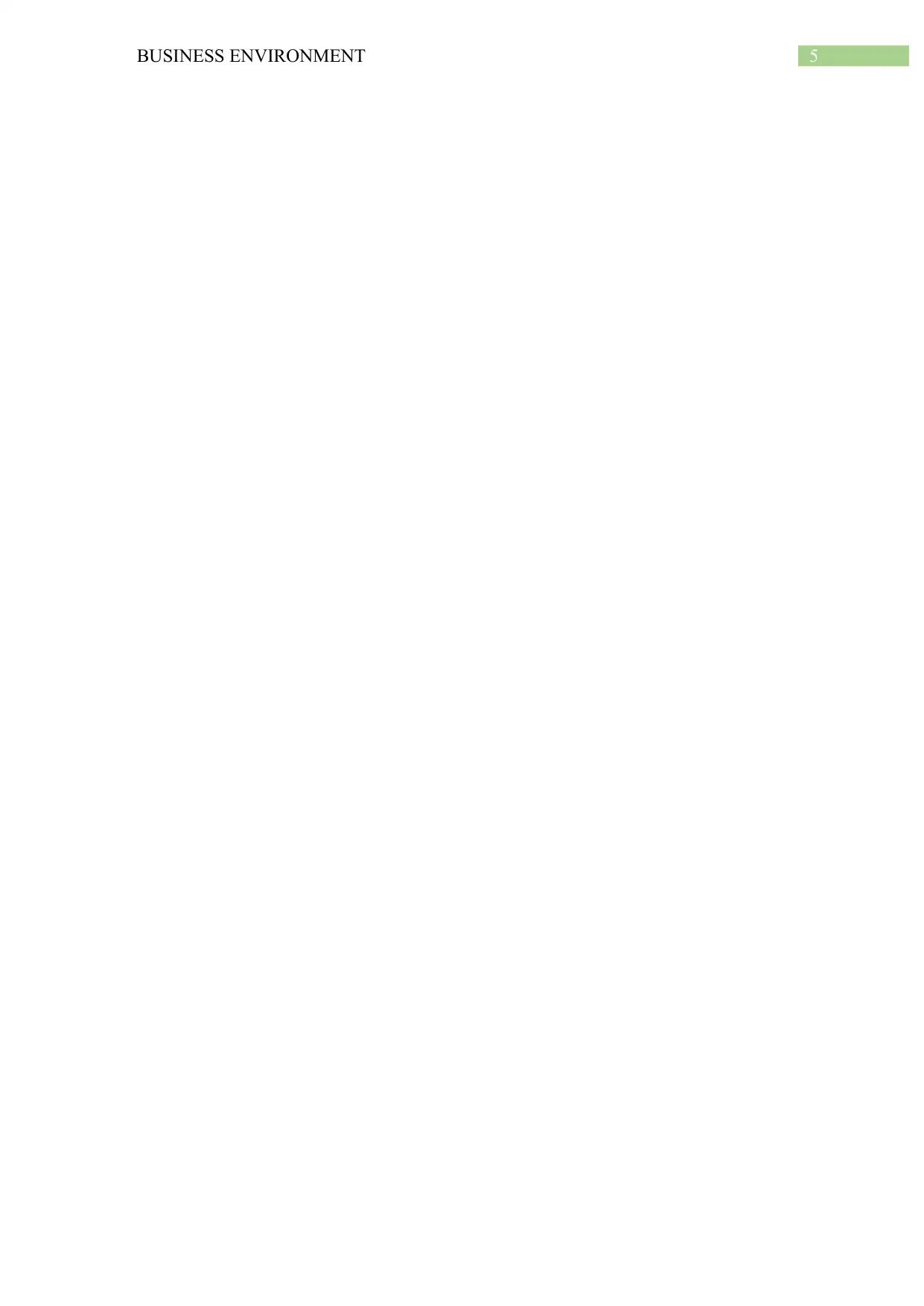
5BUSINESS ENVIRONMENT
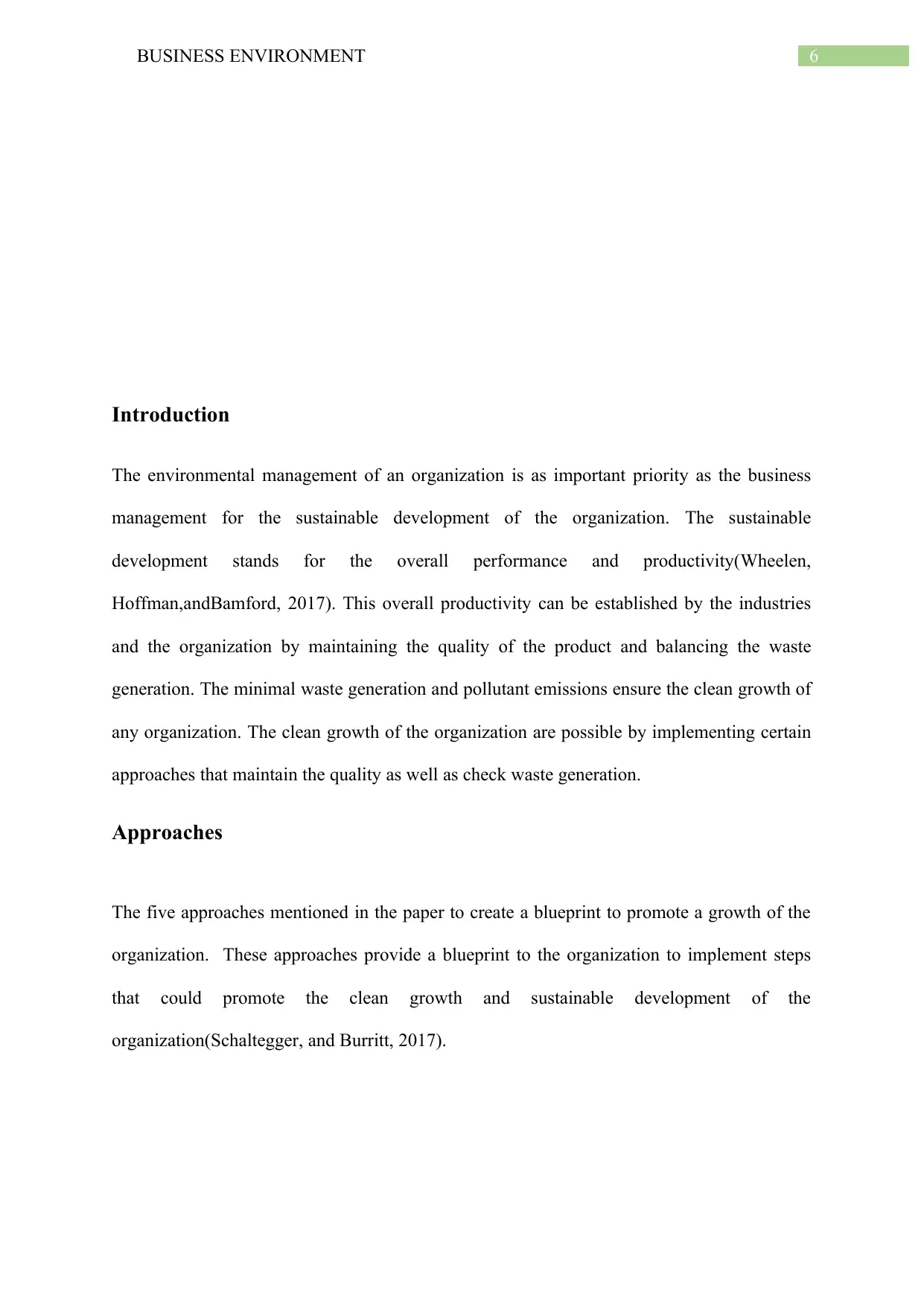
6BUSINESS ENVIRONMENT
Introduction
The environmental management of an organization is as important priority as the business
management for the sustainable development of the organization. The sustainable
development stands for the overall performance and productivity(Wheelen,
Hoffman,andBamford, 2017). This overall productivity can be established by the industries
and the organization by maintaining the quality of the product and balancing the waste
generation. The minimal waste generation and pollutant emissions ensure the clean growth of
any organization. The clean growth of the organization are possible by implementing certain
approaches that maintain the quality as well as check waste generation.
Approaches
The five approaches mentioned in the paper to create a blueprint to promote a growth of the
organization. These approaches provide a blueprint to the organization to implement steps
that could promote the clean growth and sustainable development of the
organization(Schaltegger, and Burritt, 2017).
Introduction
The environmental management of an organization is as important priority as the business
management for the sustainable development of the organization. The sustainable
development stands for the overall performance and productivity(Wheelen,
Hoffman,andBamford, 2017). This overall productivity can be established by the industries
and the organization by maintaining the quality of the product and balancing the waste
generation. The minimal waste generation and pollutant emissions ensure the clean growth of
any organization. The clean growth of the organization are possible by implementing certain
approaches that maintain the quality as well as check waste generation.
Approaches
The five approaches mentioned in the paper to create a blueprint to promote a growth of the
organization. These approaches provide a blueprint to the organization to implement steps
that could promote the clean growth and sustainable development of the
organization(Schaltegger, and Burritt, 2017).
Paraphrase This Document
Need a fresh take? Get an instant paraphrase of this document with our AI Paraphraser
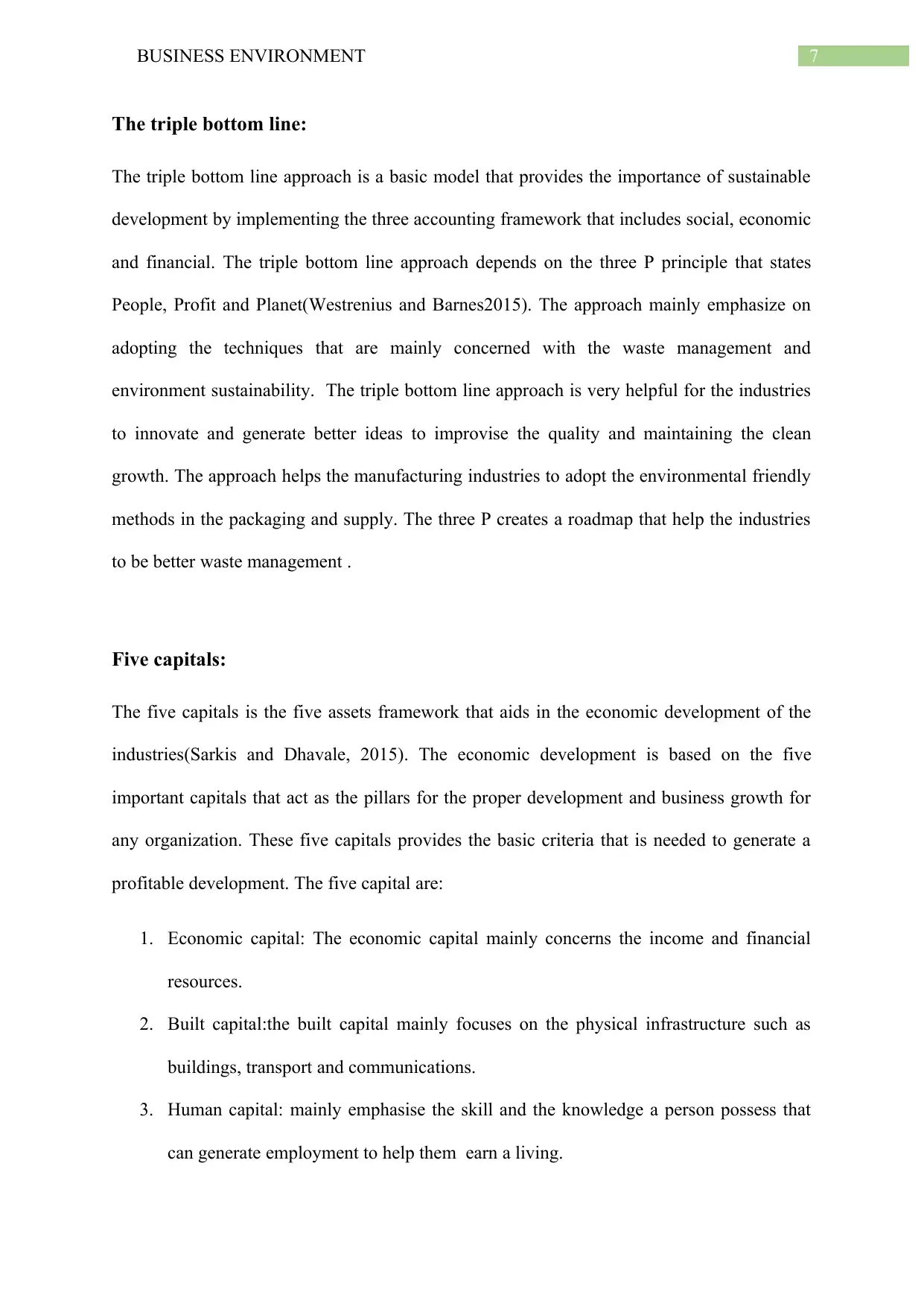
7BUSINESS ENVIRONMENT
The triple bottom line:
The triple bottom line approach is a basic model that provides the importance of sustainable
development by implementing the three accounting framework that includes social, economic
and financial. The triple bottom line approach depends on the three P principle that states
People, Profit and Planet(Westrenius and Barnes2015). The approach mainly emphasize on
adopting the techniques that are mainly concerned with the waste management and
environment sustainability. The triple bottom line approach is very helpful for the industries
to innovate and generate better ideas to improvise the quality and maintaining the clean
growth. The approach helps the manufacturing industries to adopt the environmental friendly
methods in the packaging and supply. The three P creates a roadmap that help the industries
to be better waste management .
Five capitals:
The five capitals is the five assets framework that aids in the economic development of the
industries(Sarkis and Dhavale, 2015). The economic development is based on the five
important capitals that act as the pillars for the proper development and business growth for
any organization. These five capitals provides the basic criteria that is needed to generate a
profitable development. The five capital are:
1. Economic capital: The economic capital mainly concerns the income and financial
resources.
2. Built capital:the built capital mainly focuses on the physical infrastructure such as
buildings, transport and communications.
3. Human capital: mainly emphasise the skill and the knowledge a person possess that
can generate employment to help them earn a living.
The triple bottom line:
The triple bottom line approach is a basic model that provides the importance of sustainable
development by implementing the three accounting framework that includes social, economic
and financial. The triple bottom line approach depends on the three P principle that states
People, Profit and Planet(Westrenius and Barnes2015). The approach mainly emphasize on
adopting the techniques that are mainly concerned with the waste management and
environment sustainability. The triple bottom line approach is very helpful for the industries
to innovate and generate better ideas to improvise the quality and maintaining the clean
growth. The approach helps the manufacturing industries to adopt the environmental friendly
methods in the packaging and supply. The three P creates a roadmap that help the industries
to be better waste management .
Five capitals:
The five capitals is the five assets framework that aids in the economic development of the
industries(Sarkis and Dhavale, 2015). The economic development is based on the five
important capitals that act as the pillars for the proper development and business growth for
any organization. These five capitals provides the basic criteria that is needed to generate a
profitable development. The five capital are:
1. Economic capital: The economic capital mainly concerns the income and financial
resources.
2. Built capital:the built capital mainly focuses on the physical infrastructure such as
buildings, transport and communications.
3. Human capital: mainly emphasise the skill and the knowledge a person possess that
can generate employment to help them earn a living.
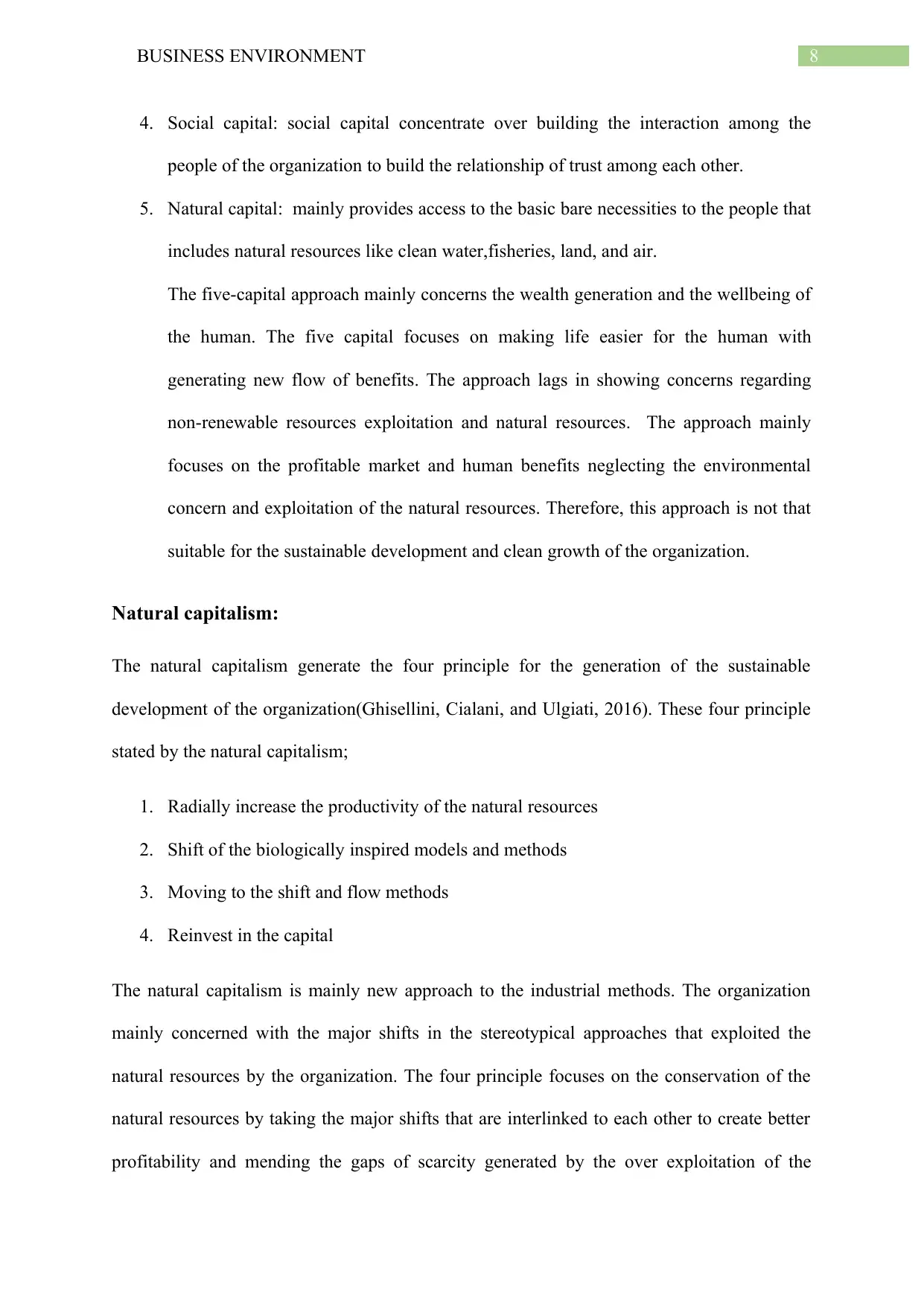
8BUSINESS ENVIRONMENT
4. Social capital: social capital concentrate over building the interaction among the
people of the organization to build the relationship of trust among each other.
5. Natural capital: mainly provides access to the basic bare necessities to the people that
includes natural resources like clean water,fisheries, land, and air.
The five-capital approach mainly concerns the wealth generation and the wellbeing of
the human. The five capital focuses on making life easier for the human with
generating new flow of benefits. The approach lags in showing concerns regarding
non-renewable resources exploitation and natural resources. The approach mainly
focuses on the profitable market and human benefits neglecting the environmental
concern and exploitation of the natural resources. Therefore, this approach is not that
suitable for the sustainable development and clean growth of the organization.
Natural capitalism:
The natural capitalism generate the four principle for the generation of the sustainable
development of the organization(Ghisellini, Cialani, and Ulgiati, 2016). These four principle
stated by the natural capitalism;
1. Radially increase the productivity of the natural resources
2. Shift of the biologically inspired models and methods
3. Moving to the shift and flow methods
4. Reinvest in the capital
The natural capitalism is mainly new approach to the industrial methods. The organization
mainly concerned with the major shifts in the stereotypical approaches that exploited the
natural resources by the organization. The four principle focuses on the conservation of the
natural resources by taking the major shifts that are interlinked to each other to create better
profitability and mending the gaps of scarcity generated by the over exploitation of the
4. Social capital: social capital concentrate over building the interaction among the
people of the organization to build the relationship of trust among each other.
5. Natural capital: mainly provides access to the basic bare necessities to the people that
includes natural resources like clean water,fisheries, land, and air.
The five-capital approach mainly concerns the wealth generation and the wellbeing of
the human. The five capital focuses on making life easier for the human with
generating new flow of benefits. The approach lags in showing concerns regarding
non-renewable resources exploitation and natural resources. The approach mainly
focuses on the profitable market and human benefits neglecting the environmental
concern and exploitation of the natural resources. Therefore, this approach is not that
suitable for the sustainable development and clean growth of the organization.
Natural capitalism:
The natural capitalism generate the four principle for the generation of the sustainable
development of the organization(Ghisellini, Cialani, and Ulgiati, 2016). These four principle
stated by the natural capitalism;
1. Radially increase the productivity of the natural resources
2. Shift of the biologically inspired models and methods
3. Moving to the shift and flow methods
4. Reinvest in the capital
The natural capitalism is mainly new approach to the industrial methods. The organization
mainly concerned with the major shifts in the stereotypical approaches that exploited the
natural resources by the organization. The four principle focuses on the conservation of the
natural resources by taking the major shifts that are interlinked to each other to create better
profitability and mending the gaps of scarcity generated by the over exploitation of the
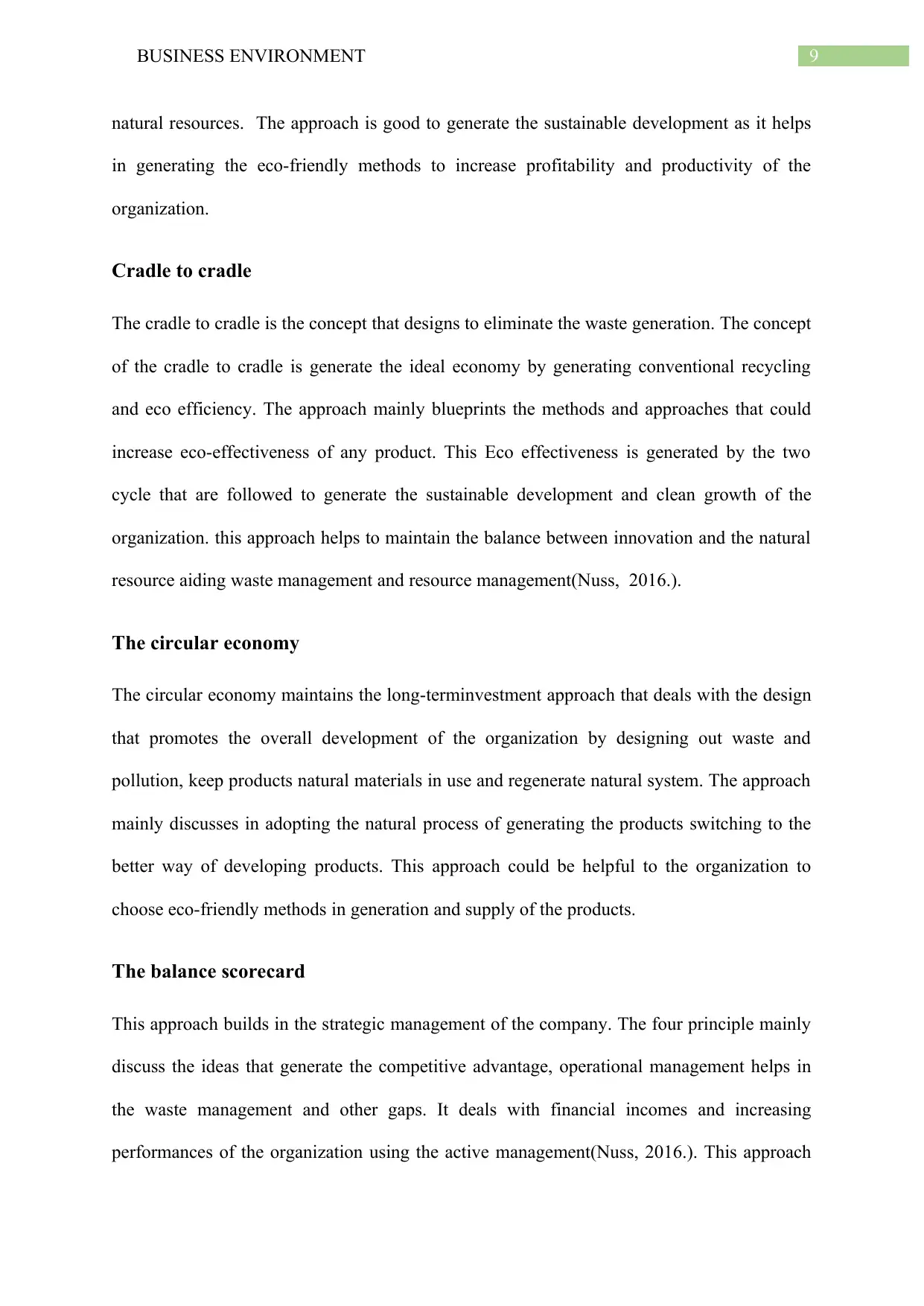
9BUSINESS ENVIRONMENT
natural resources. The approach is good to generate the sustainable development as it helps
in generating the eco-friendly methods to increase profitability and productivity of the
organization.
Cradle to cradle
The cradle to cradle is the concept that designs to eliminate the waste generation. The concept
of the cradle to cradle is generate the ideal economy by generating conventional recycling
and eco efficiency. The approach mainly blueprints the methods and approaches that could
increase eco-effectiveness of any product. This Eco effectiveness is generated by the two
cycle that are followed to generate the sustainable development and clean growth of the
organization. this approach helps to maintain the balance between innovation and the natural
resource aiding waste management and resource management(Nuss, 2016.).
The circular economy
The circular economy maintains the long-terminvestment approach that deals with the design
that promotes the overall development of the organization by designing out waste and
pollution, keep products natural materials in use and regenerate natural system. The approach
mainly discusses in adopting the natural process of generating the products switching to the
better way of developing products. This approach could be helpful to the organization to
choose eco-friendly methods in generation and supply of the products.
The balance scorecard
This approach builds in the strategic management of the company. The four principle mainly
discuss the ideas that generate the competitive advantage, operational management helps in
the waste management and other gaps. It deals with financial incomes and increasing
performances of the organization using the active management(Nuss, 2016.). This approach
natural resources. The approach is good to generate the sustainable development as it helps
in generating the eco-friendly methods to increase profitability and productivity of the
organization.
Cradle to cradle
The cradle to cradle is the concept that designs to eliminate the waste generation. The concept
of the cradle to cradle is generate the ideal economy by generating conventional recycling
and eco efficiency. The approach mainly blueprints the methods and approaches that could
increase eco-effectiveness of any product. This Eco effectiveness is generated by the two
cycle that are followed to generate the sustainable development and clean growth of the
organization. this approach helps to maintain the balance between innovation and the natural
resource aiding waste management and resource management(Nuss, 2016.).
The circular economy
The circular economy maintains the long-terminvestment approach that deals with the design
that promotes the overall development of the organization by designing out waste and
pollution, keep products natural materials in use and regenerate natural system. The approach
mainly discusses in adopting the natural process of generating the products switching to the
better way of developing products. This approach could be helpful to the organization to
choose eco-friendly methods in generation and supply of the products.
The balance scorecard
This approach builds in the strategic management of the company. The four principle mainly
discuss the ideas that generate the competitive advantage, operational management helps in
the waste management and other gaps. It deals with financial incomes and increasing
performances of the organization using the active management(Nuss, 2016.). This approach
Secure Best Marks with AI Grader
Need help grading? Try our AI Grader for instant feedback on your assignments.
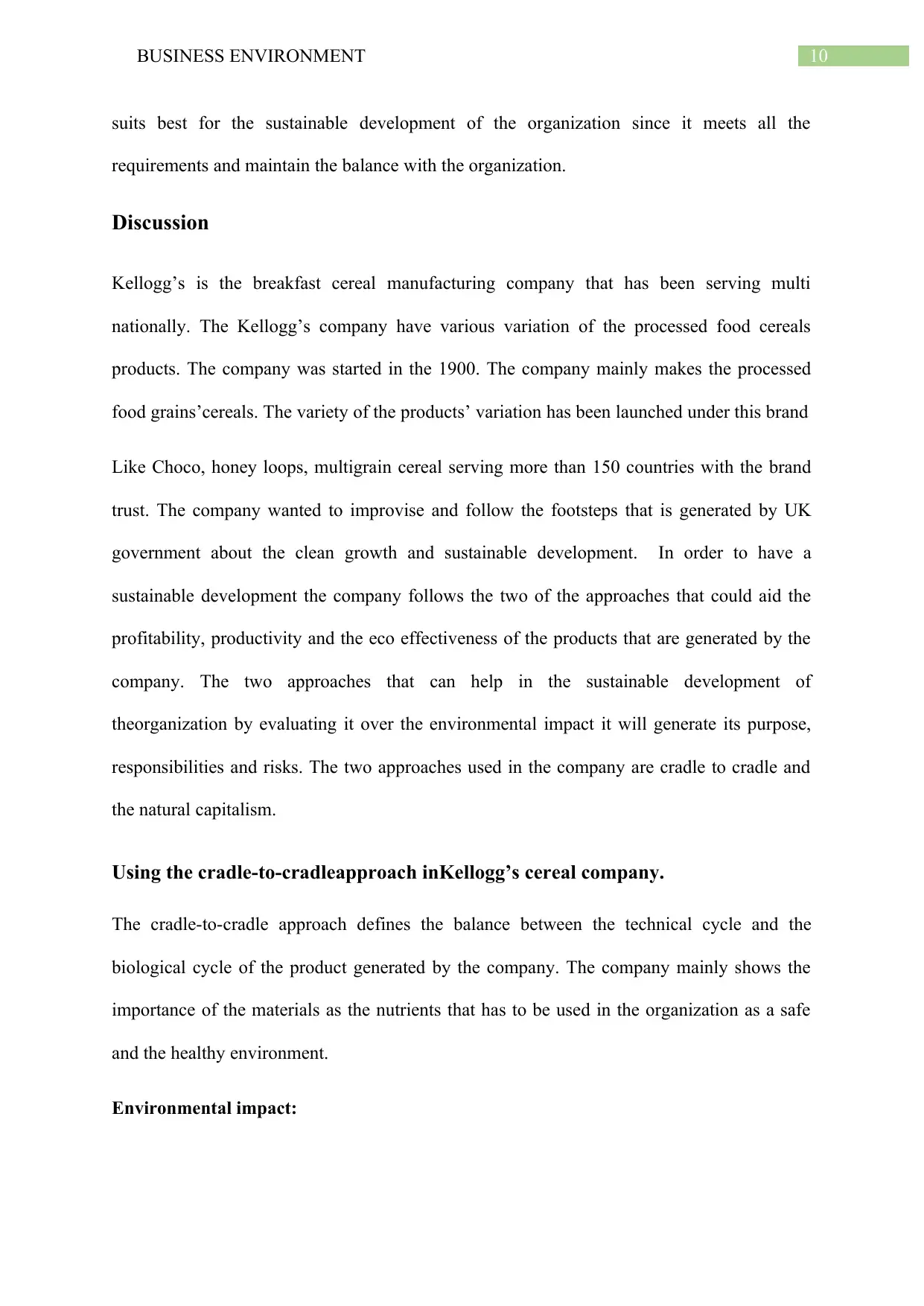
10BUSINESS ENVIRONMENT
suits best for the sustainable development of the organization since it meets all the
requirements and maintain the balance with the organization.
Discussion
Kellogg’s is the breakfast cereal manufacturing company that has been serving multi
nationally. The Kellogg’s company have various variation of the processed food cereals
products. The company was started in the 1900. The company mainly makes the processed
food grains’cereals. The variety of the products’ variation has been launched under this brand
Like Choco, honey loops, multigrain cereal serving more than 150 countries with the brand
trust. The company wanted to improvise and follow the footsteps that is generated by UK
government about the clean growth and sustainable development. In order to have a
sustainable development the company follows the two of the approaches that could aid the
profitability, productivity and the eco effectiveness of the products that are generated by the
company. The two approaches that can help in the sustainable development of
theorganization by evaluating it over the environmental impact it will generate its purpose,
responsibilities and risks. The two approaches used in the company are cradle to cradle and
the natural capitalism.
Using the cradle-to-cradleapproach inKellogg’s cereal company.
The cradle-to-cradle approach defines the balance between the technical cycle and the
biological cycle of the product generated by the company. The company mainly shows the
importance of the materials as the nutrients that has to be used in the organization as a safe
and the healthy environment.
Environmental impact:
suits best for the sustainable development of the organization since it meets all the
requirements and maintain the balance with the organization.
Discussion
Kellogg’s is the breakfast cereal manufacturing company that has been serving multi
nationally. The Kellogg’s company have various variation of the processed food cereals
products. The company was started in the 1900. The company mainly makes the processed
food grains’cereals. The variety of the products’ variation has been launched under this brand
Like Choco, honey loops, multigrain cereal serving more than 150 countries with the brand
trust. The company wanted to improvise and follow the footsteps that is generated by UK
government about the clean growth and sustainable development. In order to have a
sustainable development the company follows the two of the approaches that could aid the
profitability, productivity and the eco effectiveness of the products that are generated by the
company. The two approaches that can help in the sustainable development of
theorganization by evaluating it over the environmental impact it will generate its purpose,
responsibilities and risks. The two approaches used in the company are cradle to cradle and
the natural capitalism.
Using the cradle-to-cradleapproach inKellogg’s cereal company.
The cradle-to-cradle approach defines the balance between the technical cycle and the
biological cycle of the product generated by the company. The company mainly shows the
importance of the materials as the nutrients that has to be used in the organization as a safe
and the healthy environment.
Environmental impact:
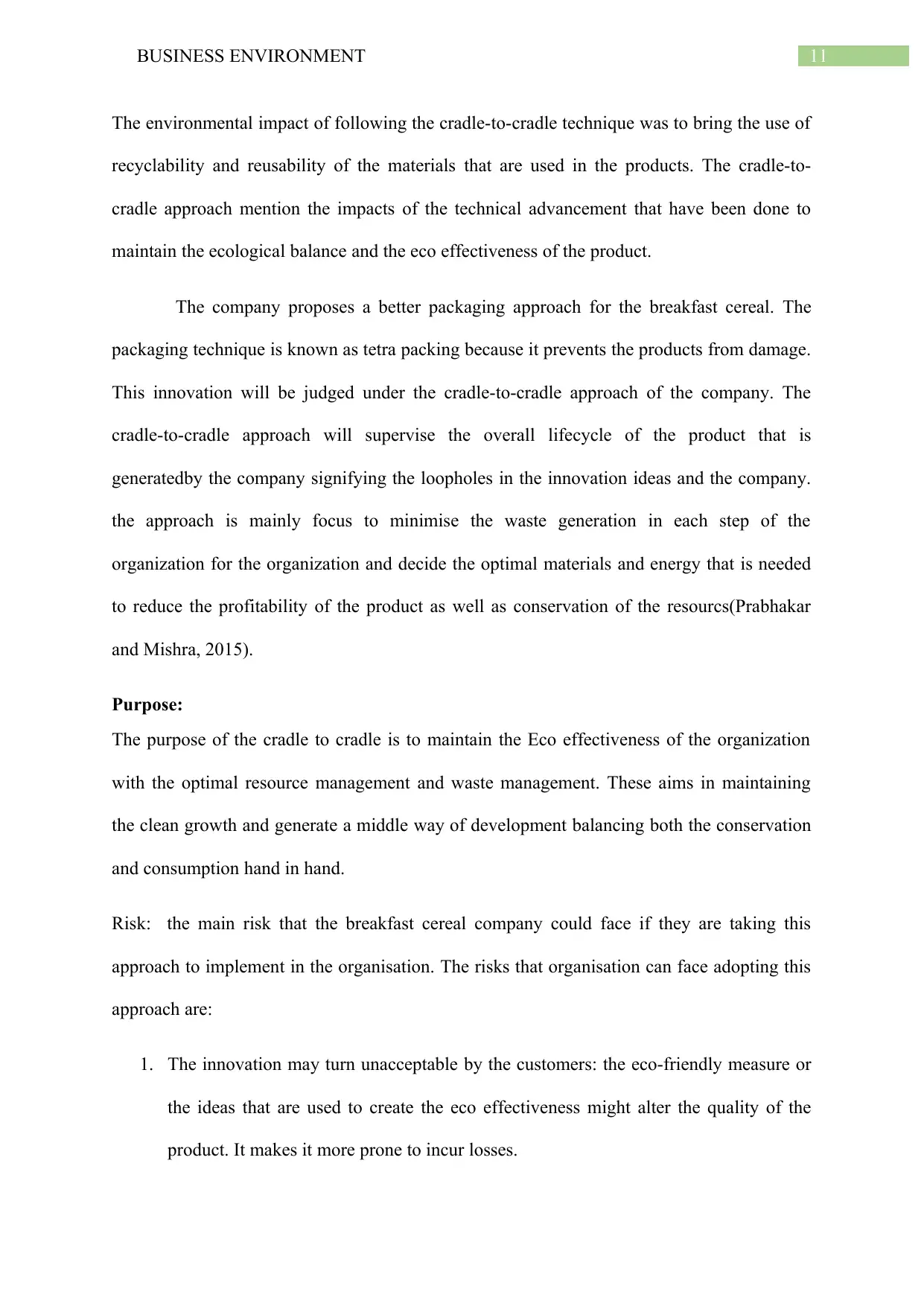
11BUSINESS ENVIRONMENT
The environmental impact of following the cradle-to-cradle technique was to bring the use of
recyclability and reusability of the materials that are used in the products. The cradle-to-
cradle approach mention the impacts of the technical advancement that have been done to
maintain the ecological balance and the eco effectiveness of the product.
The company proposes a better packaging approach for the breakfast cereal. The
packaging technique is known as tetra packing because it prevents the products from damage.
This innovation will be judged under the cradle-to-cradle approach of the company. The
cradle-to-cradle approach will supervise the overall lifecycle of the product that is
generatedby the company signifying the loopholes in the innovation ideas and the company.
the approach is mainly focus to minimise the waste generation in each step of the
organization for the organization and decide the optimal materials and energy that is needed
to reduce the profitability of the product as well as conservation of the resourcs(Prabhakar
and Mishra, 2015).
Purpose:
The purpose of the cradle to cradle is to maintain the Eco effectiveness of the organization
with the optimal resource management and waste management. These aims in maintaining
the clean growth and generate a middle way of development balancing both the conservation
and consumption hand in hand.
Risk: the main risk that the breakfast cereal company could face if they are taking this
approach to implement in the organisation. The risks that organisation can face adopting this
approach are:
1. The innovation may turn unacceptable by the customers: the eco-friendly measure or
the ideas that are used to create the eco effectiveness might alter the quality of the
product. It makes it more prone to incur losses.
The environmental impact of following the cradle-to-cradle technique was to bring the use of
recyclability and reusability of the materials that are used in the products. The cradle-to-
cradle approach mention the impacts of the technical advancement that have been done to
maintain the ecological balance and the eco effectiveness of the product.
The company proposes a better packaging approach for the breakfast cereal. The
packaging technique is known as tetra packing because it prevents the products from damage.
This innovation will be judged under the cradle-to-cradle approach of the company. The
cradle-to-cradle approach will supervise the overall lifecycle of the product that is
generatedby the company signifying the loopholes in the innovation ideas and the company.
the approach is mainly focus to minimise the waste generation in each step of the
organization for the organization and decide the optimal materials and energy that is needed
to reduce the profitability of the product as well as conservation of the resourcs(Prabhakar
and Mishra, 2015).
Purpose:
The purpose of the cradle to cradle is to maintain the Eco effectiveness of the organization
with the optimal resource management and waste management. These aims in maintaining
the clean growth and generate a middle way of development balancing both the conservation
and consumption hand in hand.
Risk: the main risk that the breakfast cereal company could face if they are taking this
approach to implement in the organisation. The risks that organisation can face adopting this
approach are:
1. The innovation may turn unacceptable by the customers: the eco-friendly measure or
the ideas that are used to create the eco effectiveness might alter the quality of the
product. It makes it more prone to incur losses.
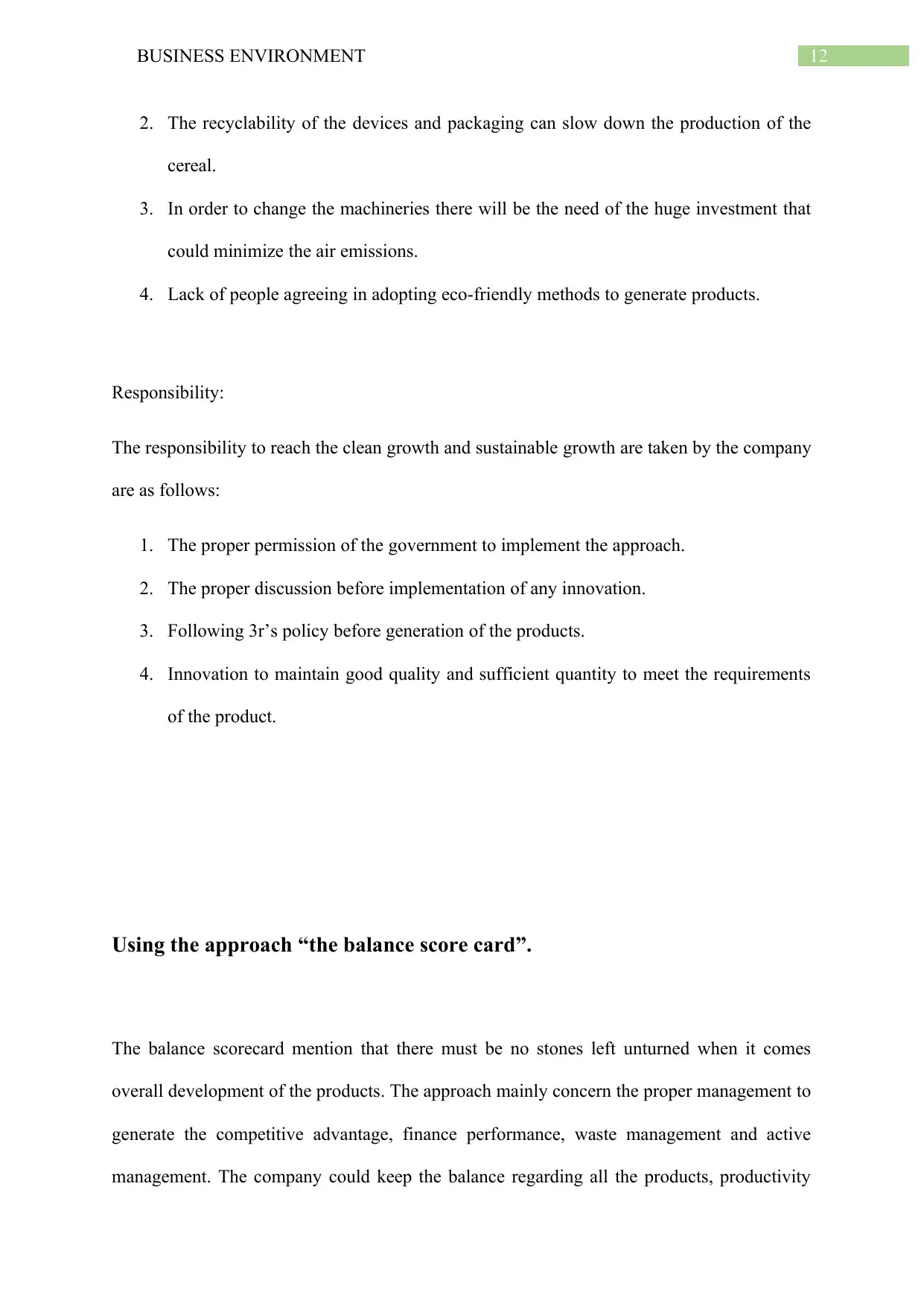
12BUSINESS ENVIRONMENT
2. The recyclability of the devices and packaging can slow down the production of the
cereal.
3. In order to change the machineries there will be the need of the huge investment that
could minimize the air emissions.
4. Lack of people agreeing in adopting eco-friendly methods to generate products.
Responsibility:
The responsibility to reach the clean growth and sustainable growth are taken by the company
are as follows:
1. The proper permission of the government to implement the approach.
2. The proper discussion before implementation of any innovation.
3. Following 3r’s policy before generation of the products.
4. Innovation to maintain good quality and sufficient quantity to meet the requirements
of the product.
Using the approach “the balance score card”.
The balance scorecard mention that there must be no stones left unturned when it comes
overall development of the products. The approach mainly concern the proper management to
generate the competitive advantage, finance performance, waste management and active
management. The company could keep the balance regarding all the products, productivity
2. The recyclability of the devices and packaging can slow down the production of the
cereal.
3. In order to change the machineries there will be the need of the huge investment that
could minimize the air emissions.
4. Lack of people agreeing in adopting eco-friendly methods to generate products.
Responsibility:
The responsibility to reach the clean growth and sustainable growth are taken by the company
are as follows:
1. The proper permission of the government to implement the approach.
2. The proper discussion before implementation of any innovation.
3. Following 3r’s policy before generation of the products.
4. Innovation to maintain good quality and sufficient quantity to meet the requirements
of the product.
Using the approach “the balance score card”.
The balance scorecard mention that there must be no stones left unturned when it comes
overall development of the products. The approach mainly concern the proper management to
generate the competitive advantage, finance performance, waste management and active
management. The company could keep the balance regarding all the products, productivity
Paraphrase This Document
Need a fresh take? Get an instant paraphrase of this document with our AI Paraphraser
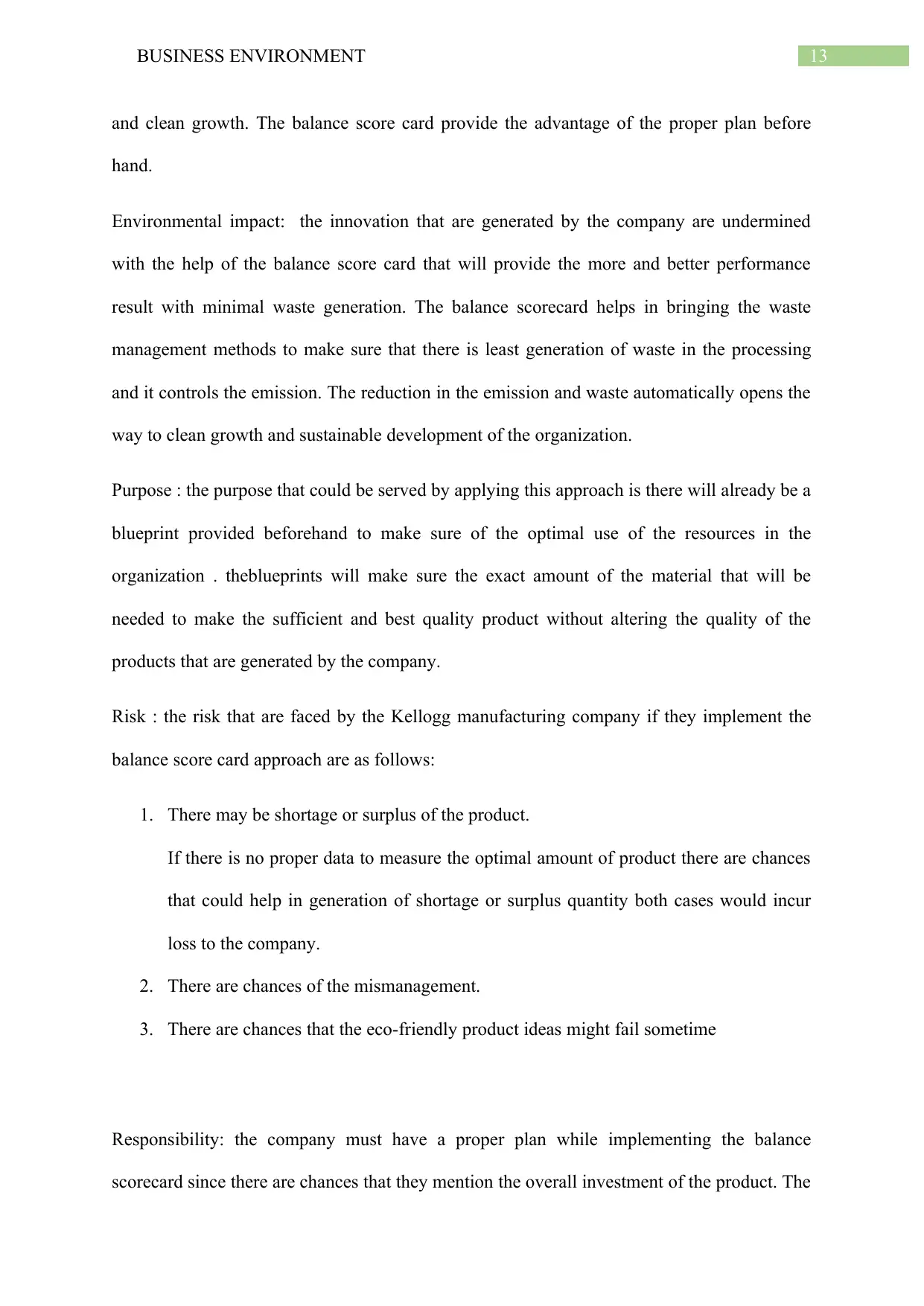
13BUSINESS ENVIRONMENT
and clean growth. The balance score card provide the advantage of the proper plan before
hand.
Environmental impact: the innovation that are generated by the company are undermined
with the help of the balance score card that will provide the more and better performance
result with minimal waste generation. The balance scorecard helps in bringing the waste
management methods to make sure that there is least generation of waste in the processing
and it controls the emission. The reduction in the emission and waste automatically opens the
way to clean growth and sustainable development of the organization.
Purpose : the purpose that could be served by applying this approach is there will already be a
blueprint provided beforehand to make sure of the optimal use of the resources in the
organization . theblueprints will make sure the exact amount of the material that will be
needed to make the sufficient and best quality product without altering the quality of the
products that are generated by the company.
Risk : the risk that are faced by the Kellogg manufacturing company if they implement the
balance score card approach are as follows:
1. There may be shortage or surplus of the product.
If there is no proper data to measure the optimal amount of product there are chances
that could help in generation of shortage or surplus quantity both cases would incur
loss to the company.
2. There are chances of the mismanagement.
3. There are chances that the eco-friendly product ideas might fail sometime
Responsibility: the company must have a proper plan while implementing the balance
scorecard since there are chances that they mention the overall investment of the product. The
and clean growth. The balance score card provide the advantage of the proper plan before
hand.
Environmental impact: the innovation that are generated by the company are undermined
with the help of the balance score card that will provide the more and better performance
result with minimal waste generation. The balance scorecard helps in bringing the waste
management methods to make sure that there is least generation of waste in the processing
and it controls the emission. The reduction in the emission and waste automatically opens the
way to clean growth and sustainable development of the organization.
Purpose : the purpose that could be served by applying this approach is there will already be a
blueprint provided beforehand to make sure of the optimal use of the resources in the
organization . theblueprints will make sure the exact amount of the material that will be
needed to make the sufficient and best quality product without altering the quality of the
products that are generated by the company.
Risk : the risk that are faced by the Kellogg manufacturing company if they implement the
balance score card approach are as follows:
1. There may be shortage or surplus of the product.
If there is no proper data to measure the optimal amount of product there are chances
that could help in generation of shortage or surplus quantity both cases would incur
loss to the company.
2. There are chances of the mismanagement.
3. There are chances that the eco-friendly product ideas might fail sometime
Responsibility: the company must have a proper plan while implementing the balance
scorecard since there are chances that they mention the overall investment of the product. The
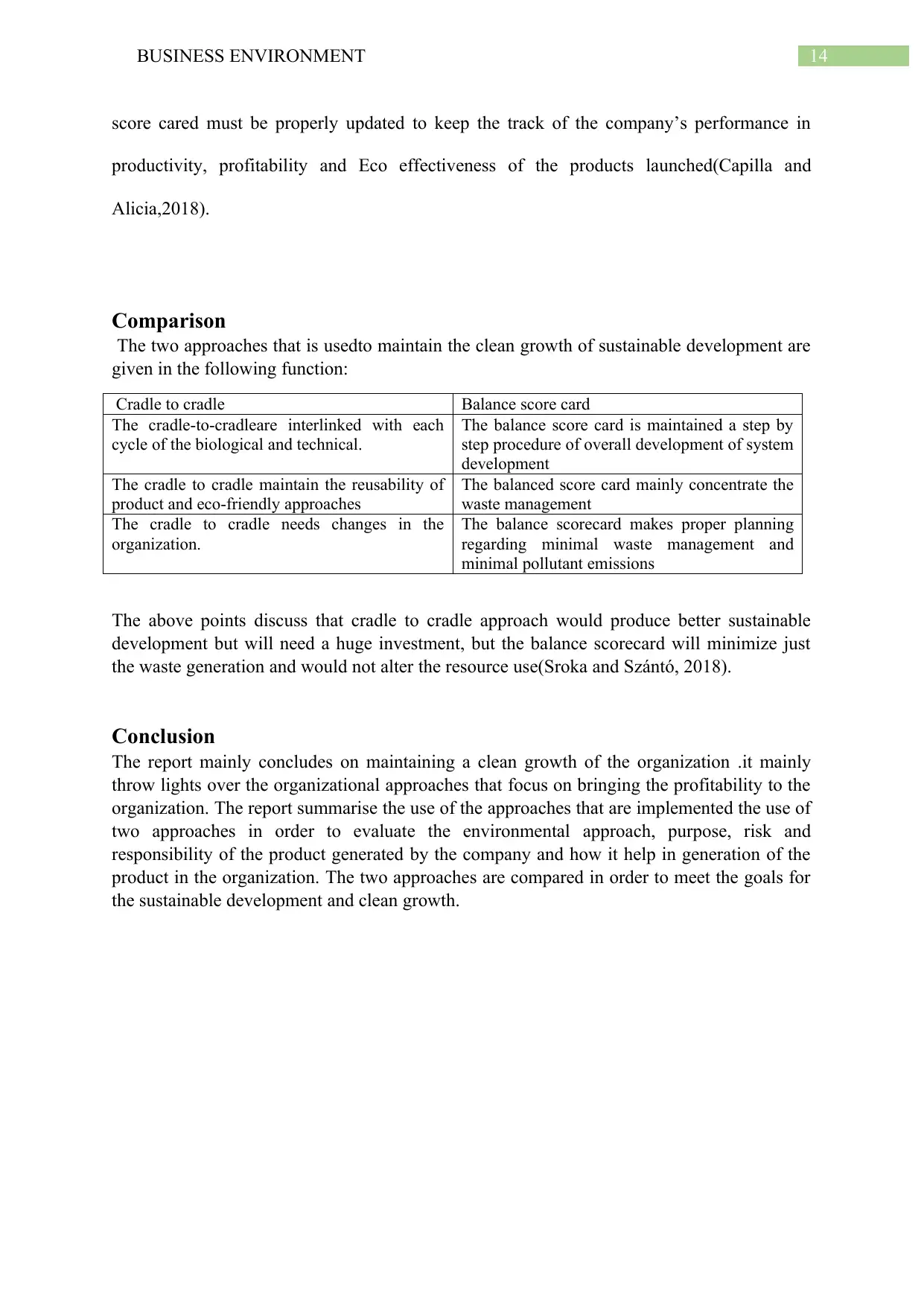
14BUSINESS ENVIRONMENT
score cared must be properly updated to keep the track of the company’s performance in
productivity, profitability and Eco effectiveness of the products launched(Capilla and
Alicia,2018).
Comparison
The two approaches that is usedto maintain the clean growth of sustainable development are
given in the following function:
Cradle to cradle Balance score card
The cradle-to-cradleare interlinked with each
cycle of the biological and technical.
The balance score card is maintained a step by
step procedure of overall development of system
development
The cradle to cradle maintain the reusability of
product and eco-friendly approaches
The balanced score card mainly concentrate the
waste management
The cradle to cradle needs changes in the
organization.
The balance scorecard makes proper planning
regarding minimal waste management and
minimal pollutant emissions
The above points discuss that cradle to cradle approach would produce better sustainable
development but will need a huge investment, but the balance scorecard will minimize just
the waste generation and would not alter the resource use(Sroka and Szántó, 2018).
Conclusion
The report mainly concludes on maintaining a clean growth of the organization .it mainly
throw lights over the organizational approaches that focus on bringing the profitability to the
organization. The report summarise the use of the approaches that are implemented the use of
two approaches in order to evaluate the environmental approach, purpose, risk and
responsibility of the product generated by the company and how it help in generation of the
product in the organization. The two approaches are compared in order to meet the goals for
the sustainable development and clean growth.
score cared must be properly updated to keep the track of the company’s performance in
productivity, profitability and Eco effectiveness of the products launched(Capilla and
Alicia,2018).
Comparison
The two approaches that is usedto maintain the clean growth of sustainable development are
given in the following function:
Cradle to cradle Balance score card
The cradle-to-cradleare interlinked with each
cycle of the biological and technical.
The balance score card is maintained a step by
step procedure of overall development of system
development
The cradle to cradle maintain the reusability of
product and eco-friendly approaches
The balanced score card mainly concentrate the
waste management
The cradle to cradle needs changes in the
organization.
The balance scorecard makes proper planning
regarding minimal waste management and
minimal pollutant emissions
The above points discuss that cradle to cradle approach would produce better sustainable
development but will need a huge investment, but the balance scorecard will minimize just
the waste generation and would not alter the resource use(Sroka and Szántó, 2018).
Conclusion
The report mainly concludes on maintaining a clean growth of the organization .it mainly
throw lights over the organizational approaches that focus on bringing the profitability to the
organization. The report summarise the use of the approaches that are implemented the use of
two approaches in order to evaluate the environmental approach, purpose, risk and
responsibility of the product generated by the company and how it help in generation of the
product in the organization. The two approaches are compared in order to meet the goals for
the sustainable development and clean growth.
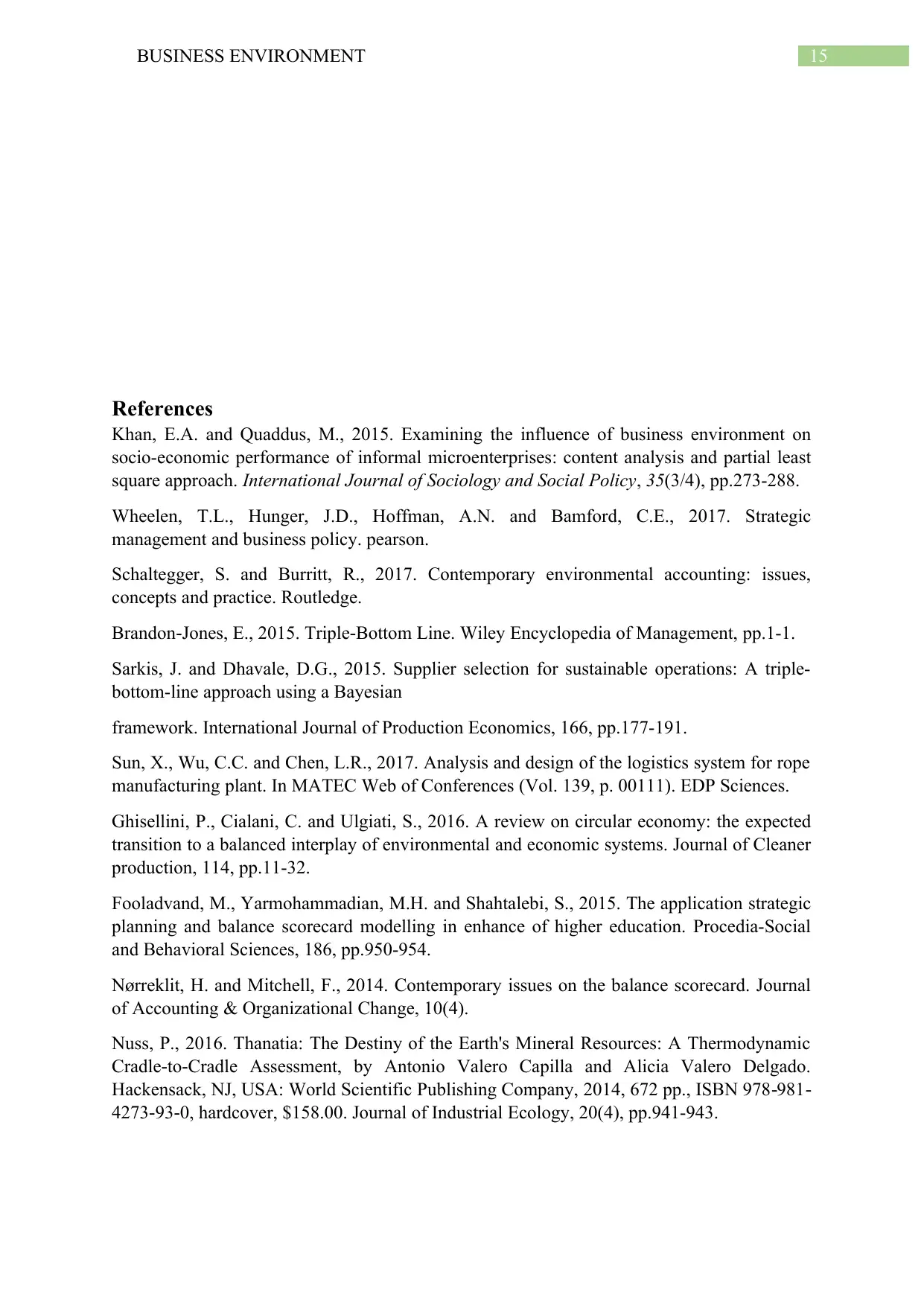
15BUSINESS ENVIRONMENT
References
Khan, E.A. and Quaddus, M., 2015. Examining the influence of business environment on
socio-economic performance of informal microenterprises: content analysis and partial least
square approach. International Journal of Sociology and Social Policy, 35(3/4), pp.273-288.
Wheelen, T.L., Hunger, J.D., Hoffman, A.N. and Bamford, C.E., 2017. Strategic
management and business policy. pearson.
Schaltegger, S. and Burritt, R., 2017. Contemporary environmental accounting: issues,
concepts and practice. Routledge.
Brandon Jones, E., 2015. Triple Bottom Line. Wiley Encyclopedia of Management, pp.1-1.‐ ‐
Sarkis, J. and Dhavale, D.G., 2015. Supplier selection for sustainable operations: A triple-
bottom-line approach using a Bayesian
framework. International Journal of Production Economics, 166, pp.177-191.
Sun, X., Wu, C.C. and Chen, L.R., 2017. Analysis and design of the logistics system for rope
manufacturing plant. In MATEC Web of Conferences (Vol. 139, p. 00111). EDP Sciences.
Ghisellini, P., Cialani, C. and Ulgiati, S., 2016. A review on circular economy: the expected
transition to a balanced interplay of environmental and economic systems. Journal of Cleaner
production, 114, pp.11-32.
Fooladvand, M., Yarmohammadian, M.H. and Shahtalebi, S., 2015. The application strategic
planning and balance scorecard modelling in enhance of higher education. Procedia-Social
and Behavioral Sciences, 186, pp.950-954.
Nørreklit, H. and Mitchell, F., 2014. Contemporary issues on the balance scorecard. Journal
of Accounting & Organizational Change, 10(4).
Nuss, P., 2016. Thanatia: The Destiny of the Earth's Mineral Resources: A Thermodynamic
Cradle to Cradle Assessment, by Antonio Valero Capilla and Alicia Valero Delgado.‐ ‐
Hackensack, NJ, USA: World Scientific Publishing Company, 2014, 672 pp., ISBN 978 981‐ ‐
4273 93 0, hardcover, $158.00. Journal of Industrial Ecology, 20(4), pp.941-943.‐ ‐
References
Khan, E.A. and Quaddus, M., 2015. Examining the influence of business environment on
socio-economic performance of informal microenterprises: content analysis and partial least
square approach. International Journal of Sociology and Social Policy, 35(3/4), pp.273-288.
Wheelen, T.L., Hunger, J.D., Hoffman, A.N. and Bamford, C.E., 2017. Strategic
management and business policy. pearson.
Schaltegger, S. and Burritt, R., 2017. Contemporary environmental accounting: issues,
concepts and practice. Routledge.
Brandon Jones, E., 2015. Triple Bottom Line. Wiley Encyclopedia of Management, pp.1-1.‐ ‐
Sarkis, J. and Dhavale, D.G., 2015. Supplier selection for sustainable operations: A triple-
bottom-line approach using a Bayesian
framework. International Journal of Production Economics, 166, pp.177-191.
Sun, X., Wu, C.C. and Chen, L.R., 2017. Analysis and design of the logistics system for rope
manufacturing plant. In MATEC Web of Conferences (Vol. 139, p. 00111). EDP Sciences.
Ghisellini, P., Cialani, C. and Ulgiati, S., 2016. A review on circular economy: the expected
transition to a balanced interplay of environmental and economic systems. Journal of Cleaner
production, 114, pp.11-32.
Fooladvand, M., Yarmohammadian, M.H. and Shahtalebi, S., 2015. The application strategic
planning and balance scorecard modelling in enhance of higher education. Procedia-Social
and Behavioral Sciences, 186, pp.950-954.
Nørreklit, H. and Mitchell, F., 2014. Contemporary issues on the balance scorecard. Journal
of Accounting & Organizational Change, 10(4).
Nuss, P., 2016. Thanatia: The Destiny of the Earth's Mineral Resources: A Thermodynamic
Cradle to Cradle Assessment, by Antonio Valero Capilla and Alicia Valero Delgado.‐ ‐
Hackensack, NJ, USA: World Scientific Publishing Company, 2014, 672 pp., ISBN 978 981‐ ‐
4273 93 0, hardcover, $158.00. Journal of Industrial Ecology, 20(4), pp.941-943.‐ ‐
Secure Best Marks with AI Grader
Need help grading? Try our AI Grader for instant feedback on your assignments.
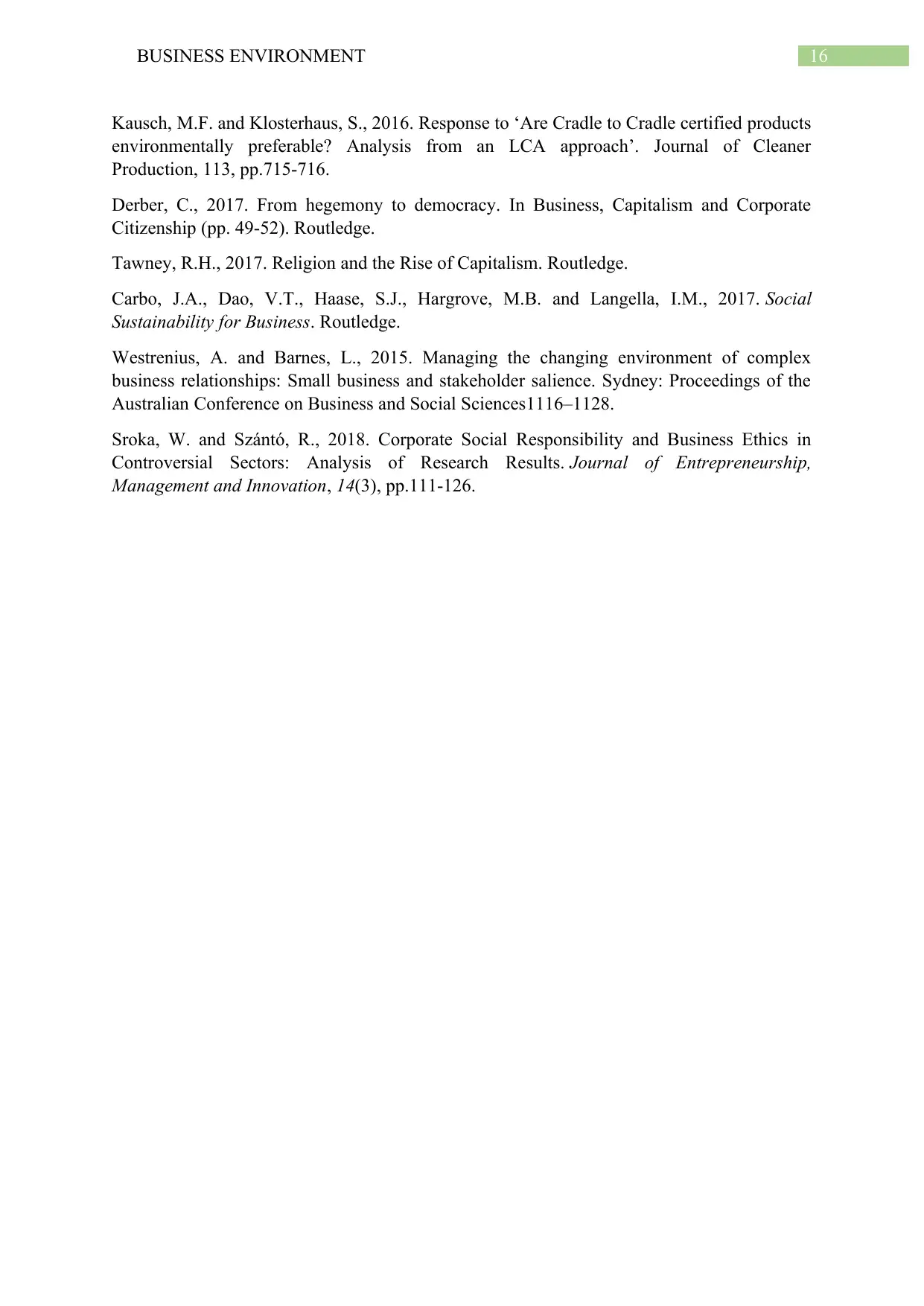
16BUSINESS ENVIRONMENT
Kausch, M.F. and Klosterhaus, S., 2016. Response to ‘Are Cradle to Cradle certified products
environmentally preferable? Analysis from an LCA approach’. Journal of Cleaner
Production, 113, pp.715-716.
Derber, C., 2017. From hegemony to democracy. In Business, Capitalism and Corporate
Citizenship (pp. 49-52). Routledge.
Tawney, R.H., 2017. Religion and the Rise of Capitalism. Routledge.
Carbo, J.A., Dao, V.T., Haase, S.J., Hargrove, M.B. and Langella, I.M., 2017. Social
Sustainability for Business. Routledge.
Westrenius, A. and Barnes, L., 2015. Managing the changing environment of complex
business relationships: Small business and stakeholder salience. Sydney: Proceedings of the
Australian Conference on Business and Social Sciences1116–1128.
Sroka, W. and Szántó, R., 2018. Corporate Social Responsibility and Business Ethics in
Controversial Sectors: Analysis of Research Results. Journal of Entrepreneurship,
Management and Innovation, 14(3), pp.111-126.
Kausch, M.F. and Klosterhaus, S., 2016. Response to ‘Are Cradle to Cradle certified products
environmentally preferable? Analysis from an LCA approach’. Journal of Cleaner
Production, 113, pp.715-716.
Derber, C., 2017. From hegemony to democracy. In Business, Capitalism and Corporate
Citizenship (pp. 49-52). Routledge.
Tawney, R.H., 2017. Religion and the Rise of Capitalism. Routledge.
Carbo, J.A., Dao, V.T., Haase, S.J., Hargrove, M.B. and Langella, I.M., 2017. Social
Sustainability for Business. Routledge.
Westrenius, A. and Barnes, L., 2015. Managing the changing environment of complex
business relationships: Small business and stakeholder salience. Sydney: Proceedings of the
Australian Conference on Business and Social Sciences1116–1128.
Sroka, W. and Szántó, R., 2018. Corporate Social Responsibility and Business Ethics in
Controversial Sectors: Analysis of Research Results. Journal of Entrepreneurship,
Management and Innovation, 14(3), pp.111-126.
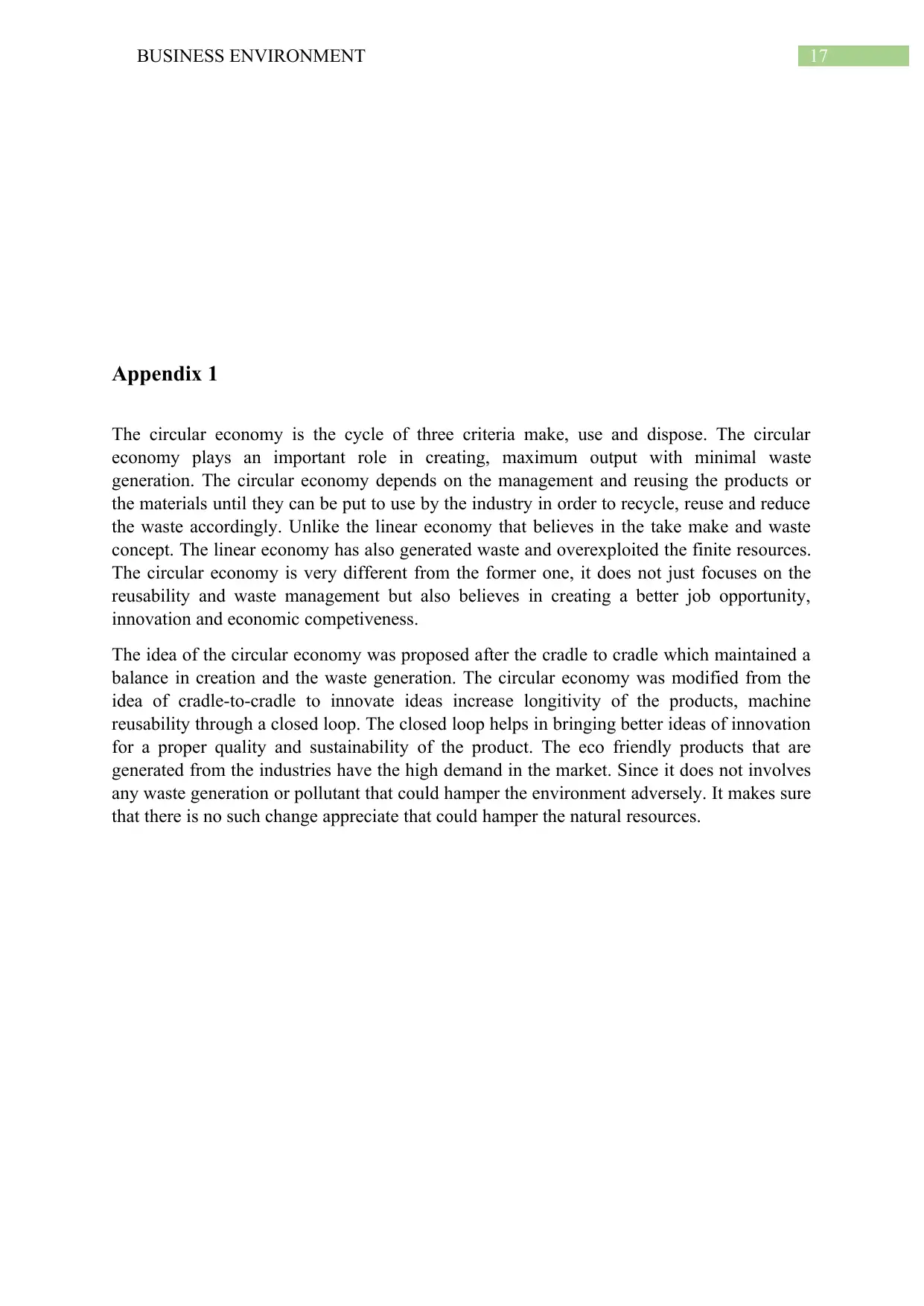
17BUSINESS ENVIRONMENT
Appendix 1
The circular economy is the cycle of three criteria make, use and dispose. The circular
economy plays an important role in creating, maximum output with minimal waste
generation. The circular economy depends on the management and reusing the products or
the materials until they can be put to use by the industry in order to recycle, reuse and reduce
the waste accordingly. Unlike the linear economy that believes in the take make and waste
concept. The linear economy has also generated waste and overexploited the finite resources.
The circular economy is very different from the former one, it does not just focuses on the
reusability and waste management but also believes in creating a better job opportunity,
innovation and economic competiveness.
The idea of the circular economy was proposed after the cradle to cradle which maintained a
balance in creation and the waste generation. The circular economy was modified from the
idea of cradle-to-cradle to innovate ideas increase longitivity of the products, machine
reusability through a closed loop. The closed loop helps in bringing better ideas of innovation
for a proper quality and sustainability of the product. The eco friendly products that are
generated from the industries have the high demand in the market. Since it does not involves
any waste generation or pollutant that could hamper the environment adversely. It makes sure
that there is no such change appreciate that could hamper the natural resources.
Appendix 1
The circular economy is the cycle of three criteria make, use and dispose. The circular
economy plays an important role in creating, maximum output with minimal waste
generation. The circular economy depends on the management and reusing the products or
the materials until they can be put to use by the industry in order to recycle, reuse and reduce
the waste accordingly. Unlike the linear economy that believes in the take make and waste
concept. The linear economy has also generated waste and overexploited the finite resources.
The circular economy is very different from the former one, it does not just focuses on the
reusability and waste management but also believes in creating a better job opportunity,
innovation and economic competiveness.
The idea of the circular economy was proposed after the cradle to cradle which maintained a
balance in creation and the waste generation. The circular economy was modified from the
idea of cradle-to-cradle to innovate ideas increase longitivity of the products, machine
reusability through a closed loop. The closed loop helps in bringing better ideas of innovation
for a proper quality and sustainability of the product. The eco friendly products that are
generated from the industries have the high demand in the market. Since it does not involves
any waste generation or pollutant that could hamper the environment adversely. It makes sure
that there is no such change appreciate that could hamper the natural resources.

18BUSINESS ENVIRONMENT
Appendix 2
The triple bottom line can be sub categorise in three parts: economical, sustainable and
financial. The three bottom line are shown by the three P’s Planet, profit and People. The
triple bottom line believes in generation economy by keeping a balance between the three
P of the society. The business models have been accepted on the level of government and
fedral, states and even in the local levels. The triple bottom line believe in generation of the
economy through better ideas and innovation that can bring better quality products even by
keeping the idea of the maintaining the balance between the 3P’s . The innovation helps in
bringing the better approach to the products that have been launched in the markets with
lesser waste generation.
The triple bottom line maintains the balance between the natural resources and product
quality hand in hand. The Triple bottom line helps in building the platform to check the
company’s progress in both commercial and environmental scale. The model help the
company to set a benchmark in the market for developing innovation and ideas that involves
the concern of the environment. The model helps in building a company’s impact and also set
new approach of adopting better measure that does not affect the environment adversely
which one was done by the linear model of economy that overexploited the finitive reserves
and generate high quality waste. The triple bottom line is one of the best way of creating
business model that collaborate with the environment and nature.
Appendix 2
The triple bottom line can be sub categorise in three parts: economical, sustainable and
financial. The three bottom line are shown by the three P’s Planet, profit and People. The
triple bottom line believes in generation economy by keeping a balance between the three
P of the society. The business models have been accepted on the level of government and
fedral, states and even in the local levels. The triple bottom line believe in generation of the
economy through better ideas and innovation that can bring better quality products even by
keeping the idea of the maintaining the balance between the 3P’s . The innovation helps in
bringing the better approach to the products that have been launched in the markets with
lesser waste generation.
The triple bottom line maintains the balance between the natural resources and product
quality hand in hand. The Triple bottom line helps in building the platform to check the
company’s progress in both commercial and environmental scale. The model help the
company to set a benchmark in the market for developing innovation and ideas that involves
the concern of the environment. The model helps in building a company’s impact and also set
new approach of adopting better measure that does not affect the environment adversely
which one was done by the linear model of economy that overexploited the finitive reserves
and generate high quality waste. The triple bottom line is one of the best way of creating
business model that collaborate with the environment and nature.
1 out of 19
Related Documents
Your All-in-One AI-Powered Toolkit for Academic Success.
+13062052269
info@desklib.com
Available 24*7 on WhatsApp / Email
![[object Object]](/_next/static/media/star-bottom.7253800d.svg)
Unlock your academic potential
© 2024 | Zucol Services PVT LTD | All rights reserved.





